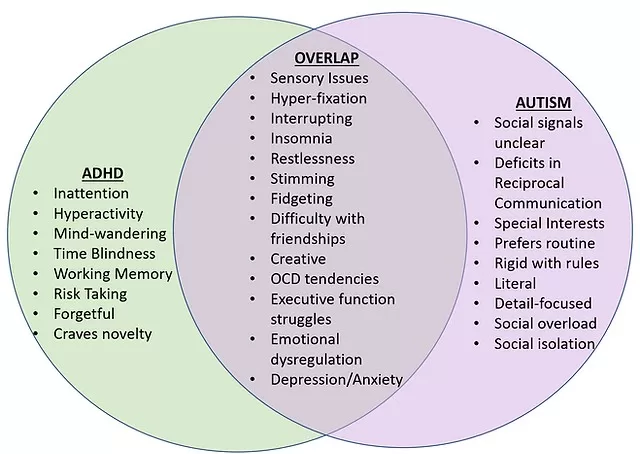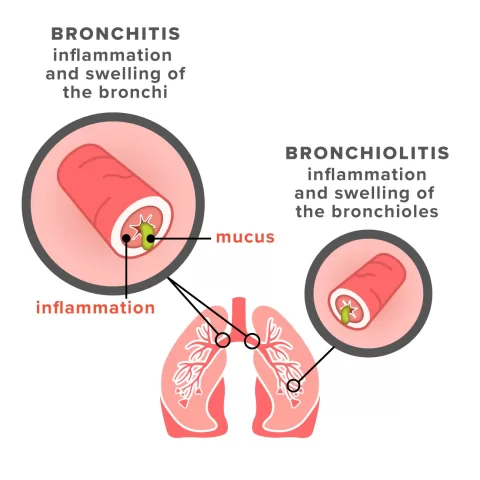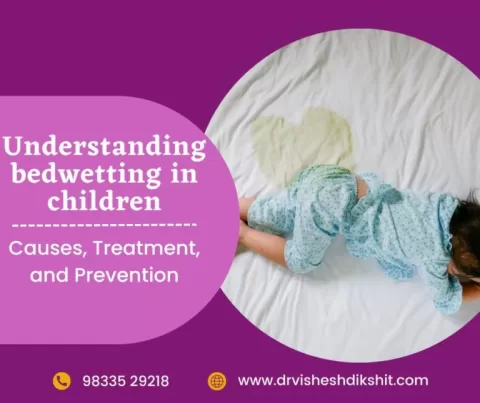AuDHD, the intersection of autism and ADHD, represents a complex landscape for adults navigating life with these co-occurring conditions. Often, the symptoms of adult ADHD can mirror those of autism, making accurate diagnosis and treatment essential yet challenging. As clinicians explore these diagnoses in adults, they recognize that understanding each individual’s unique experiences greatly influences their management strategies. With a growing body of research underscoring the prevalence of autism and ADHD in adults, it becomes clear that tailored interventions and adult autism treatments are crucial for enhancing quality of life. By addressing the needs associated with these co-existing disorders, we can foster better support for individuals coping with the symptoms of ADHD and autism.
In the realm of neurodevelopmental disorders, the combination of ADHD and autism presents individuals with distinct hurdles that require careful consideration and intervention. Often referred to as co-occurring conditions, this dual diagnosis ensures that symptoms such as inattentiveness, hyperactivity, and social communication deficits are recognized in a holistic manner. Clinicians and researchers are increasingly aware of the overlaps and unique presentations that arise from such conditions, leading to a better understanding of adult autism diagnosis and its implications. The complexity of navigating adult life with this combination demands innovative approaches to treatment and support that address the needs of those affected. By shedding light on these intertwined challenges, we can contribute to a broader conversation around effective management and understanding of ADHD symptoms in adults.
Understanding AuDHD: ADHD and Autism Spectrum Disorder
AuDHD, a term combining autism and ADHD, signifies the overlapping nature of these neurodevelopmental disorders that frequently co-occur in adults. As clinical awareness of AuDHD grows, so too does the recognition that individuals navigating both conditions face distinct challenges that can hinder their everyday functioning. Notably, symptoms such as inattention, social difficulties, and sensory sensitivities often manifest in complex ways, making it imperative for clinicians to utilize comprehensive diagnostic assessments that account for these intertwined features.
Research indicates that individuals with both AuDHD may experience heightened functional impairments compared to those with a single diagnosis. For adults, these challenges can impact relationships, vocational success, and overall mental health. Therefore, understanding the dual presentation of ADHD symptoms, such as impulsivity and hyperactivity, alongside the social communication deficits typical of autism is crucial for developing effective intervention strategies.
Evaluating Symptoms in Adult Audhd
Evaluating individuals for AuDHD involves a nuanced understanding of both autism and ADHD symptoms. For autism, the DSM-5 outlines criteria focusing on persistent difficulties in social communication and interaction, along with restrictive and repetitive patterns of behavior. Clinicians also need to assess the individual’s social emotional reciprocity, non-verbal communication, and the ability to maintain relationships. This thorough evaluation process ensures that clinicians can distinguish between the symptoms of ADHD and the behavioral manifestations of autism.
Moreover, ADHD’s hallmark symptoms—such as distractibility, hyperactivity, and impulsiveness—may overlay with those of autism, leading to potential misdiagnosis. This overlapping symptomatology highlights the necessity for specialized assessments that include developmental histories, observational tools like the Autism Diagnostic Observation Schedule-2 (ADOS), and standardized questionnaires. By prioritizing comprehensive diagnostic tools, clinicians can facilitate accurate evaluations that inform appropriate treatment plans.
Signs of Adult ADHD Symptoms
In adults, ADHD symptoms often present as chronic difficulties in attention and self-regulation, which can severely affect various aspects of life. These signs may include persistent disorganization, forgetfulness, and an inability to complete tasks. Importantly, understanding ADHD in adults requires recognizing how these symptoms manifest differently than in children; for instance, an adult with ADHD may struggle with maintaining employment due to difficulties in time management and prioritizing tasks.
It’s also essential to consider the emotional and social repercussions of living with ADHD. Adults may experience higher levels of anxiety and depression related to their symptoms, particularly when they face challenges in relationships or workplace settings. Thus, awareness of adult ADHD symptoms is crucial for appropriate diagnosis and the formulation of effective therapeutic approaches tailored to enhance quality of life.
Adult Autism Diagnosis and Challenges
Receiving an autism diagnosis in adulthood is often a complex process, often initiated when individuals seek evaluation due to struggles in daily functioning, relationships, or career stability. Unbeknownst to many, this quest for understanding their identity can be triggered by the increasing visibility of autism in popular media or through discussions in online communities. However, navigating this diagnostic journey presents unique challenges, including limited access to experienced clinicians and the need for comprehensive evaluation methods that respect the adult’s lived experiences.
Furthermore, many adults may have developed coping mechanisms that mask autistic traits over time, complicating the diagnostic process. Clinicians must approach assessments with sensitivity, utilizing tools that consider the nuances of adult experiences with autism, such as adaptive behavior assessments and structured diagnostic interviews. Adjusting the diagnostic timeline and framework allows for a more accurate representation of the individual’s experiences and challenges.
Interventions for Adults with AuDHD
Effective interventions for adults with AuDHD must be multi-faceted, addressing both ADHD and autism symptoms. While pharmacological treatments such as stimulant medications can help manage ADHD symptoms, non-pharmacological approaches, including Cognitive Behavioral Therapy (CBT) and psychoeducation, play a crucial role in enhancing independence and improving coping strategies. These therapies can empower individuals to better manage their symptoms, fostering a greater quality of life.
Educational and vocational supports are also essential in intervention strategies, focusing on personalized adaptations that suit individual needs. For example, helping clients set realistic career goals and providing accommodations in work environments can significantly enhance performance and satisfaction. Implementing strategies aimed at enhancing executive function, such as the Flexible Futures program, can create pathways for adults with AuDHD to thrive in their personal and professional lives.
The Role of Co-Occurring Conditions in AuDHD
Co-occurring conditions represent a significant factor in understanding AuDHD. Adults diagnosed with autism may experience additional mental health conditions such as anxiety, depression, or obsessive-compulsive disorder, compounding their challenges. It’s crucial for clinicians to consider these co-occurring conditions when crafting treatment plans since untreated comorbidities can hinder the effectiveness of primary interventions for ADHD or autism.
Research indicates that individuals with AuDHD who also experience anxiety or mood disorders might require additional therapeutic support tailored to their specific needs. Understanding the full spectrum of co-occurring conditions helps clinicians provide holistic care that addresses both the mental health aspect and the neurodevelopmental disorders. By ensuring comprehensive management strategies, individuals can achieve improved outcomes and a better quality of life.
Best Practices for AuDHD Treatment
Implementing best practices in treating AuDHD necessitates an individualized approach that accommodates the unique needs of each patient. Starting medications at lower doses is advised due to potential sensitivities among those with dual diagnoses. Additionally, clinicians should foster open communication with patients, utilizing visual aids and other supportive tools to help gauge treatment responses effectively.
Moreover, regular assessment and adjustment of treatment strategies based on ongoing feedback ensures that interventions remain relevant and effective. Emphasizing a collaborative treatment model will encourage participation from the individual, aiding in developing self-management skills that empower them in navigating daily challenges associated with AuDHD.
Understanding the Impact of AuDHD on Daily Life
Living with AuDHD can significantly impact various facets of daily life, including social interactions, employment, and personal relationships. Individuals often need to navigate complex social situations that can be overwhelming, especially when faced with executive function difficulties due to ADHD. This discord can lead to feelings of isolation or frustration, making it crucial for support networks—such as friends, family, and mental health professionals—to understand their experiences.
Furthermore, daily skills such as organization and time management can be particularly challenging for individuals with AuDHD. Building strategies to assist with routine tasks, such as using reminders or organizational tools, can help create a more manageable daily structure. By fostering supportive environments that acknowledge these challenges, adults with AuDHD can build fulfilling lives and attain success in areas previously deemed difficult.
Resources for Adults Living with AuDHD
As awareness of AuDHD continues to rise, numerous resources have emerged to support adults managing both autism and ADHD. Organizations providing educational materials, community forums, and advocacy resources play an essential role in helping individuals connect with others experiencing similar challenges. This sense of community can significantly improve mental well-being by reducing feelings of isolation and offering practical coping strategies.
In addition to community support, accessing reputable online content, workshops, and seminars can equip individuals with vital knowledge about living with AuDHD. These resources educate on effective self-advocacy strategies and engagement in treatment options, helping individuals take control of their health journeys. Encouraging adults to explore these avenues is key to empowering them to thrive amid their unique challenges.
Frequently Asked Questions
What is AuDHD and how does it relate to autism and ADHD?
AuDHD refers to the co-occurrence of autism and ADHD, two neurodevelopmental conditions that affect individuals at significantly elevated rates. Adults with AuDHD often face unique challenges as symptoms of both disorders can overlap, impacting social interactions and daily functioning. Understanding AuDHD is crucial for effective diagnosis and intervention.
What are common ADHD symptoms in adults with AuDHD?
Adults with AuDHD may exhibit classic ADHD symptoms such as inattention, hyperactivity, and impulsivity. However, these symptoms can often blend with autism traits, making accurate diagnosis essential. Clinicians need to consider the full spectrum of behaviors and challenges presented by individuals with both autism and ADHD.
How is adult autism diagnosed and what role does AuDHD play?
The diagnosis of adult autism involves a comprehensive evaluation that assesses social communication deficits and repetitive behaviors, with AuDHD necessitating careful differentiation between symptoms of autism and ADHD. Professionals utilize tools like developmental histories, observation schedules, and screening questionnaires to ensure an accurate diagnosis.
What are some effective treatments for adults with AuDHD?
Currently, treatments for AuDHD include a combination of non-pharmacological approaches such as Cognitive Behavioral Therapy (CBT) and executive function therapies, alongside pharmacological options like stimulant medications for ADHD symptoms. Tailoring interventions to individual needs is essential for improving quality of life.
What challenges do adults with co-occurring autism and ADHD face?
Adults with co-occurring autism and ADHD often experience greater functional impairments, especially in social settings and employment. This can lead to complex challenges related to independence and relationship management. Understanding these challenges is crucial for developing effective support strategies.
How can adults with AuDHD manage their symptoms effectively?
Managing symptoms of AuDHD effectively typically involves developing personalized coping strategies, seeking therapy for executive functioning skills, and utilizing educational or vocational supports that accommodate both autism and ADHD traits. Awareness and proactive interventions can significantly enhance daily functioning.
Why is it important to screen for both autism and ADHD in adults?
Screening for both autism and ADHD in adults is vital because their symptoms can overlap, and diagnosing one condition without recognizing the other may lead to suboptimal treatment. Effective assessment helps clinicians create targeted interventions that address the full scope of an individual’s needs.
Are there special considerations in the treatment of AuDHD in adults?
Yes, when treating AuDHD in adults, clinicians should start medications at low doses, recognizing that individuals may respond differently due to co-occurring conditions. Open communication and the use of visual supports during treatment discussions can enhance understanding and treatment compliance.
What resources are available for adults living with AuDHD?
Adults living with AuDHD can benefit from resources such as articles and guides provided by organizations like ADDitude magazine, which focus on managing ADHD and autism in adulthood. These resources offer valuable strategies for improving relationships, career success, and daily living.
How prevalent is AuDHD among adults?
Research indicates that between 20% to 37% of adults with autism also have symptoms of ADHD, making AuDHD a common co-occurring condition. This high prevalence underscores the importance of understanding the interaction between autism and ADHD in adults.
| Key Area | Description |
|---|---|
| Overview | AuDHD refers to the co-occurrence of autism and ADHD in adults, leading to significant challenges and functional impairments. |
| Evaluation and Diagnosis | Clinicians use DSM-5 criteria to assess social communication challenges and behaviors for diagnosing autism. |
| Symptoms of Autism | Defined by difficulties in social interaction and communication, as well as repetitive behaviors. |
| Adult Assessment | Diagnosis often follows a referral; assessments incorporate various tools and observational methods. |
| Adult Autism & ADHD | 20%-37% of individuals may have both conditions, necessitating careful differential assessment. |
| Treatment and Interventions | Most strategies are derived from children’s treatments and focus on enhancing quality of life through non-pharmacological and pharmacological approaches. |
| Best Practices | Starting medications at low doses is advised, along with effective communication methods. |
Summary
AuDHD refers to the co-occurrence of ADHD and autism in adults, which presents unique challenges that require tailored assessment and intervention strategies. Increased awareness and resources are crucial to support adults facing these dual diagnoses. By understanding the overlap in symptoms and implementing best practices in treatment, clinicians can significantly improve the quality of life for individuals with AuDHD.
The content provided on this blog (e.g., symptom descriptions, health tips, or general advice) is for informational purposes only and is not a substitute for professional medical advice, diagnosis, or treatment. Always seek the guidance of your physician or other qualified healthcare provider with any questions you may have regarding a medical condition. Never disregard professional medical advice or delay seeking it because of something you have read on this website. If you believe you may have a medical emergency, call your doctor or emergency services immediately. Reliance on any information provided by this blog is solely at your own risk.








